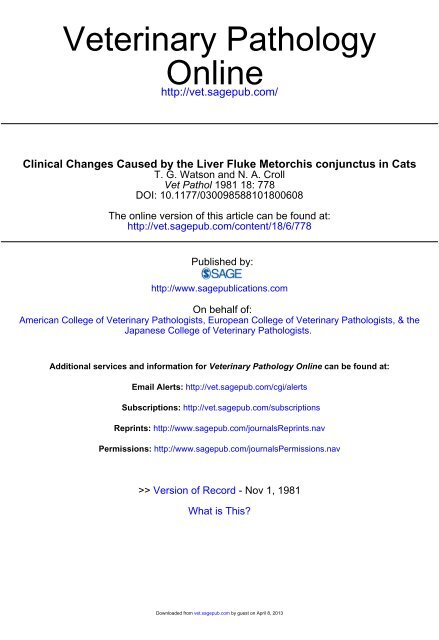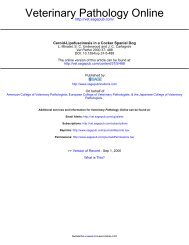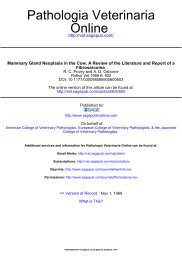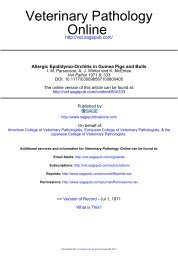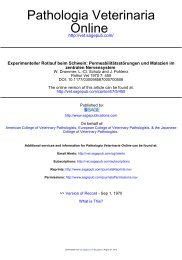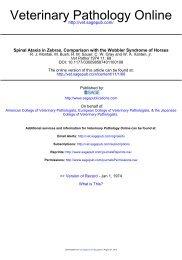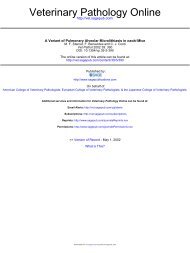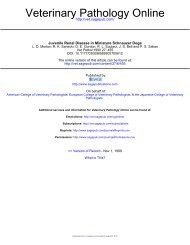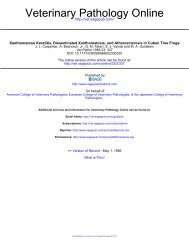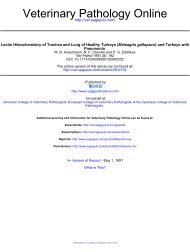Clinical Changes Caused by the Liver Fluke Metorchis conjunctus in
Clinical Changes Caused by the Liver Fluke Metorchis conjunctus in
Clinical Changes Caused by the Liver Fluke Metorchis conjunctus in
You also want an ePaper? Increase the reach of your titles
YUMPU automatically turns print PDFs into web optimized ePapers that Google loves.
Veter<strong>in</strong>ary Pathology<br />
Onl<strong>in</strong>e<br />
http://vet.sagepub.com/<br />
<strong>Cl<strong>in</strong>ical</strong> <strong>Changes</strong> <strong>Caused</strong> <strong>by</strong> <strong>the</strong> <strong>Liver</strong> <strong>Fluke</strong> <strong>Metorchis</strong> <strong>conjunctus</strong> <strong>in</strong> Cats<br />
T. G. Watson and N. A. Croll<br />
Vet Pathol 1981 18: 778<br />
DOI: 10.1177/030098588101800608<br />
The onl<strong>in</strong>e version of this article can be found at:<br />
http://vet.sagepub.com/content/18/6/778<br />
Published <strong>by</strong>:<br />
http://www.sagepublications.com<br />
On behalf of:<br />
American College of Veter<strong>in</strong>ary Pathologists, European College of Veter<strong>in</strong>ary Pathologists, & <strong>the</strong><br />
Japanese College of Veter<strong>in</strong>ary Pathologists.<br />
Additional services and <strong>in</strong>formation for Veter<strong>in</strong>ary Pathology Onl<strong>in</strong>e can be found at:<br />
Email Alerts: http://vet.sagepub.com/cgi/alerts<br />
Subscriptions: http://vet.sagepub.com/subscriptions<br />
Repr<strong>in</strong>ts: http://www.sagepub.com/journalsRepr<strong>in</strong>ts.nav<br />
Permissions: http://www.sagepub.com/journalsPermissions.nav<br />
>> Version of Record - Nov 1, 1981<br />
What is This?<br />
Downloaded from<br />
vet.sagepub.com <strong>by</strong> guest on April 8, 2013
Vet. Pathol. 18: 778-785 (1981)<br />
<strong>Cl<strong>in</strong>ical</strong> <strong>Changes</strong> <strong>Caused</strong> <strong>by</strong> <strong>the</strong> <strong>Liver</strong> <strong>Fluke</strong> <strong>Metorchis</strong> <strong>conjunctus</strong> <strong>in</strong><br />
Cats<br />
T. G. WATSON and N. A. CROLL<br />
Institute of Parasitology, Macdonald College of McGill University, Ste. Anne de Bellevue,<br />
Quebec, Canada<br />
Abstract. Cats <strong>in</strong>fected with metacercariae of <strong>the</strong> fluke <strong>Metorchis</strong> <strong>conjunctus</strong> were followed<br />
cl<strong>in</strong>ically through <strong>the</strong>ir <strong>in</strong>fection. Cats given 200 metacercariae showed few symptoms. All <strong>the</strong><br />
cats passed ova on <strong>the</strong> 17th day. Three hundred metacercariae caused diarrhea, icterus,<br />
discolored ur<strong>in</strong>e, green feces and eos<strong>in</strong>ophilia after 18 to 21 days. Eos<strong>in</strong>ophilia, Ieuc<strong>in</strong>e<br />
am<strong>in</strong>opeptidase and alan<strong>in</strong>e am<strong>in</strong>otransferase were elevated and rema<strong>in</strong> <strong>the</strong> best <strong>in</strong>dicators<br />
for metorchiasis. The hematological and serological abnormalities resolved rapidly and were<br />
absent from cats with chronic <strong>in</strong>fection.<br />
Acute lesions (
<strong>Metorchis</strong> <strong>in</strong> Cats 119<br />
Materials and Methods<br />
Male and female mixed-breed cats weigh<strong>in</strong>g 1.0 to 3.5 kg were treated with piperaz<strong>in</strong>e to<br />
expel Toxocara cati and <strong>the</strong>n housed <strong>in</strong> cages with a mesh bottom and a plate to rest on.<br />
Water was provided ad libitum and each cat had about 100 g of Pur<strong>in</strong>a cat chow (Centre<br />
Agricole St. Clet, St. Clet, County Soulanges, P.Q.) daily; feces were exam<strong>in</strong>ed for ova with<br />
<strong>the</strong> formal<strong>in</strong>-e<strong>the</strong>r technique [ 171.<br />
Viable metacercariae were digested from <strong>the</strong> muscles of <strong>the</strong> common sucker (Catastomus<br />
commersoni) <strong>in</strong> artificial gastric medium. They were placed on <strong>the</strong> back of <strong>the</strong> cat’s tongue<br />
and were swallowed or flushed down <strong>the</strong> throat; cats were observed carefully to rule out<br />
vomit<strong>in</strong>g of <strong>the</strong> <strong>in</strong>oculum.<br />
Blood collection was done between 0800 and 1000 hours. Cats were sedated with ketam<strong>in</strong>e<br />
hydrochloride (0.05 mg/kg body weight); 4 ml of whole blood was removed <strong>by</strong> cardiac<br />
puncture with an 18 gauge needle and 5 ml syr<strong>in</strong>ge. Hepar<strong>in</strong>ked, microhematocrit capillary<br />
tubes were filled with whole blood for leukocyte and eos<strong>in</strong>ophil counts <strong>in</strong> Unopette dilut<strong>in</strong>g<br />
chambers (Becton-Dick<strong>in</strong>son, Ru<strong>the</strong>rford, N.J.). The hematocrit packed cell volume was<br />
measured from <strong>the</strong> rema<strong>in</strong><strong>in</strong>g capillary. The rema<strong>in</strong><strong>in</strong>g blood was clotted at 22°C for 30 to 40<br />
m<strong>in</strong>utes. The serum was frozen at - 17°C <strong>in</strong> 2- or 4-dram vials. The follow<strong>in</strong>g tests were done:<br />
total serum prote<strong>in</strong>, album<strong>in</strong>, and globul<strong>in</strong> (Sigma, St. Louis, Mo.), with a Coleman Junior I1<br />
Model 6/20 spectrophotometer (Canadian Coleman Co. Ltd., Toronto, Ont.); serum prote<strong>in</strong><br />
electrophoresis was done with a Corn<strong>in</strong>g 740 densitometer; serum bilirub<strong>in</strong>, leuc<strong>in</strong>e am<strong>in</strong>o-<br />
peptidase and alan<strong>in</strong>e am<strong>in</strong>otransferase activity were determ<strong>in</strong>ed <strong>by</strong> Boehr<strong>in</strong>ger Ingelheim<br />
Mannheim GmbH Diagnostica (Waterford, Conn.); alkal<strong>in</strong>e phosphatase was quantified <strong>by</strong><br />
Sigma (St. Louis, Mo.) technical procedures.<br />
Three experimental <strong>in</strong>fections were given as follows: Experiment I: Five cats, coded 1 to 5,<br />
were given 200 metacercariae apiece while two controls were given placebo. Blood samples<br />
were taken two days prior to <strong>in</strong>fection, immediately prior to <strong>in</strong>fection and on days 2, 4, 6, 8,<br />
12,20 and 32 post-<strong>in</strong>fection, when <strong>the</strong> cats were killed. Experiment 2: Cats 6 and 7 each were<br />
given 300 metacercariae. Blood was sampled before <strong>in</strong>fection and at weekly <strong>in</strong>tervals after<br />
<strong>in</strong>fection until <strong>the</strong>y were killed at day 59 (cat 6) and day 78 (cat 7). Experiment 3: Cats 8 to 12,<br />
three female and two male littermates weigh<strong>in</strong>g 1.5 to 3.0 kg, were used. Two cats received 200<br />
metacercariae, two received 300 and one was given placebo. Blood was collected before<br />
<strong>in</strong>fection and on days 7, 14, 17, 21, 24, and 28 and <strong>the</strong>n weekly until day 77. On day 42 <strong>the</strong><br />
two cats given 200 metacercariae were given 300 more metacercariae apiece; <strong>the</strong>ir blood was<br />
collected until day 9 1.<br />
Each cat was anes<strong>the</strong>tized <strong>by</strong> ketam<strong>in</strong>e, a f<strong>in</strong>al blood sample was taken and <strong>the</strong> cat was<br />
killed with an <strong>in</strong>tracardiac overdose of Somnotol (M.T.C. Pharmaceuticals, Hamilton, Ont.).<br />
After midl<strong>in</strong>e <strong>in</strong>cision, <strong>the</strong> ductus choledochus was ligated at <strong>the</strong> duodenum and <strong>the</strong> duodenum<br />
was ligated above and below <strong>the</strong> ampulla of Vater. The gall bladder, cystic duct, common bile<br />
duct and ductus choledochus were separated, as were <strong>the</strong> lobes of <strong>the</strong> liver. Each lobe was<br />
sliced <strong>in</strong>to 2- to 3-mm wedges and all tissues were exam<strong>in</strong>ed for flukes. Representative tissues<br />
were fixed <strong>in</strong> 10% formaldehyde. The spleen, pancreas and viscera were exam<strong>in</strong>ed for worms,<br />
lesions or enlarged nodes.<br />
Results<br />
The cats did not show identical or <strong>in</strong> some cases even similar cl<strong>in</strong>ical courses. Each<br />
experiment will be discussed briefly, typical case histories presented and f<strong>in</strong>ally <strong>the</strong><br />
collected data will be given.<br />
Experiment 1. <strong>Cl<strong>in</strong>ical</strong> signs-rectal temperature, food <strong>in</strong>take, stool quality, color,<br />
Downloaded from<br />
vet.sagepub.com <strong>by</strong> guest on April 8, 2013
780 Watson and Croll<br />
or consistency, ur<strong>in</strong>e output, vomit<strong>in</strong>g, and behavior-were not different between<br />
<strong>the</strong> controls and <strong>the</strong> <strong>in</strong>fected cats. All <strong>in</strong>fected cats passed ova from <strong>the</strong> 17th day<br />
post-<strong>in</strong>fection, and M. <strong>conjunctus</strong> was found <strong>in</strong> <strong>the</strong> biliary trees. Significant changes<br />
(p = 0.05) <strong>in</strong> <strong>the</strong> measured parameters were exam<strong>in</strong>ed <strong>by</strong> analysis of variance on log<br />
transformed raw data. Differences were sought among <strong>the</strong> controls or among <strong>the</strong><br />
experimental cats dur<strong>in</strong>g <strong>the</strong> <strong>in</strong>fection and, f<strong>in</strong>ally, between <strong>the</strong> controls and experi-<br />
mental cats on each day of sampl<strong>in</strong>g. Experimental cats showed: a significant<br />
eos<strong>in</strong>ophilia from days 12 to 32; a significant <strong>in</strong>crease <strong>in</strong> album<strong>in</strong>/globul<strong>in</strong> ratio; a<br />
significant elevation <strong>in</strong> (YZ globul<strong>in</strong>, alan<strong>in</strong>e am<strong>in</strong>otransferase and leuc<strong>in</strong>e am<strong>in</strong>opep-<br />
tidase.<br />
Experiment 2. Cat 6 was asymptomatic until fluke patency on day 17 when it<br />
passed brown, watery feces without mucus, with ova. The diarrhea lasted for about<br />
36 hours and returned irregularly until day 5 1; <strong>the</strong>n it became cont<strong>in</strong>uous until day<br />
59, when <strong>the</strong> cat was killed. Necropsy showed 252 adults of M. <strong>conjunctus</strong> (84%<br />
establishment) with 80 <strong>in</strong> each lateral lobe and 24, 24, and 23 respectively <strong>in</strong> <strong>the</strong><br />
median lobes. No worms were found <strong>in</strong> <strong>the</strong> gall bladder or cystic duct, but 21 were<br />
toge<strong>the</strong>r <strong>in</strong> <strong>the</strong> common duct and extra-hepatic lobar ducts. No flukes were <strong>in</strong> <strong>the</strong><br />
caudal lobe.<br />
Cat 7 followed a more spectacular cl<strong>in</strong>ical course and is considered a typical case<br />
of symptomatic metorchiasis (table I). The cat was without symptoms until day 14,<br />
when it developed scleral and dermal icterus, and <strong>the</strong> serum changed from pale straw<br />
color to a canary yellow color. On day 14 <strong>the</strong> cat was emaciated, wet <strong>in</strong> <strong>the</strong> perianal<br />
region, and had a rectal temperature of 38.5"C. It refused food and water, was anuric<br />
and constipated on day 15, and had a temperature of 38.9"C. On day 16, reddish-<br />
brown ur<strong>in</strong>e was expelled manually from <strong>the</strong> bladder. The cat lay <strong>in</strong> its cage, moved<br />
only when <strong>in</strong>duced, had stiff legs, and was apparently <strong>in</strong> considerable discomfort.<br />
On day 17, 38.6 g of dense, gray feces with ova were expelled with a little yellow<br />
mucus. The temperature was 38.9"C and a little reddish-brown ur<strong>in</strong>e was on <strong>the</strong><br />
floor of <strong>the</strong> cage; <strong>the</strong> cat ate and drank. By day 21 <strong>the</strong> cat could move slowly, ate<br />
more vigorously, and expelled firm green feces. By day 22 <strong>the</strong> feces seemed more<br />
normal and <strong>by</strong> day 28 <strong>the</strong> feces were normal and <strong>the</strong> serum was aga<strong>in</strong> straw colored.<br />
The cat was killed on day 120.<br />
All hepatic lobes of cat 7 were <strong>in</strong>fected with M. <strong>conjunctus</strong>. There were 112 worms<br />
<strong>in</strong> <strong>the</strong> ma<strong>in</strong> <strong>in</strong>trahepatic ducts of <strong>the</strong> left lateral lobe, 19 <strong>in</strong> <strong>the</strong> right lateral, 1 <strong>in</strong> <strong>the</strong><br />
median, 48 <strong>in</strong> <strong>the</strong> right median and 3 <strong>in</strong> <strong>the</strong> caudal lobe. One worm was <strong>in</strong> <strong>the</strong> cystic<br />
duct, with a total of 183 adults (63% establishment).<br />
<strong>Cl<strong>in</strong>ical</strong> laboratory values for cat 7 are given <strong>in</strong> table I. There was significant<br />
eos<strong>in</strong>ophilia <strong>in</strong> both cats between days 18 and 21. Leuc<strong>in</strong>e am<strong>in</strong>opeptidase and<br />
alan<strong>in</strong>e am<strong>in</strong>otransferase were elevated significantly <strong>in</strong> cats 6 and 7 between days 7<br />
and 2 1 post-<strong>in</strong>fection. No significant change occurred <strong>in</strong> alkal<strong>in</strong>e phosphatase. Total<br />
serum prote<strong>in</strong> was stable <strong>in</strong> cat 6, but it was greatly elevated on days 18 to 21 <strong>in</strong> cat<br />
7, which had concurrent severe cl<strong>in</strong>ical signs. On day 18 this elevation resulted from<br />
<strong>in</strong>creased globul<strong>in</strong> despite depressed album<strong>in</strong> and a globul<strong>in</strong>.<br />
Downloaded from<br />
vet.sagepub.com <strong>by</strong> guest on April 8, 2013
Table I. Hematological and serological f<strong>in</strong>d<strong>in</strong>gs for cat 7, <strong>in</strong>oculated with 300 metacercariae<br />
Globul<strong>in</strong> Bilirub<strong>in</strong><br />
Eos<strong>in</strong>ophils Prot Alb Glob Alb LAP SAP AAT<br />
#/nun3% g/dl g/dl g/dl A/G % a p y w' ml SU/1 1U/I Tot Dir Indir<br />
% % % mg/dl mg/dl mg/dl 5<br />
- 2<br />
387 2.1 6.6 3.30 3.30 1.00 50.2 29.6 11.1 18.5 5.50 0.42 39.8 0.194 -<br />
2-<br />
480 2.1 6.1 3.00 3.10 0.97 48.4 20.0 11.3 20.4 5.00 1.00 707.1 0.270 0.115 0.155 F'<br />
5'<br />
1920 7.9 7.8 3.68 4.12 0.89 47.2 23.9 12.1 16.9 8.83 2.02 348.7 7.852 5.774 2.078<br />
5858 29.0 8.9 3.90 5.00 0.78 42.5 24.9 14.1 18.2 8.30 0.98 317.3 3.080 1.840 1.240 E i:<br />
4746 19.1 7.7 3.50 4.20 0.83 45.6 23.5 12.7 18.0 7.16 2.30 364.6 1.210 0.650 0.560<br />
1616 6.7 6.9 3.15 3.75 0.84 45.5 23.2 12.1 18.9 6.66 1.38 151.8 0.454 0.144 0.310<br />
WBC<br />
x 103<br />
/m3<br />
<strong>by</strong> guest on April 8, 2013<br />
18.5<br />
22.3<br />
24.4<br />
20.2<br />
22.6<br />
24.1<br />
vet.sagepub.com<br />
post-<strong>in</strong>fection; WBC = white blood cells; alb = album<strong>in</strong>; glob = globul<strong>in</strong>; A/G = album<strong>in</strong>: globul<strong>in</strong> ratio;<br />
= leuc<strong>in</strong>e am<strong>in</strong>opeptidase; SAP = serum alkal<strong>in</strong>e phosphatase; AAT = alan<strong>in</strong>e amhotransferase.<br />
Downloaded from
782<br />
,OOt<br />
I<br />
b I<br />
Watson and Croll<br />
300<br />
7 14 21 28 35 42 49 56 63 70 77 84 91<br />
DAYS POST INOCULATION<br />
Fig. 1: Absolute numbers of eos<strong>in</strong>ophils <strong>in</strong> circulation of two cats given 200 metacercariae<br />
of <strong>Metorchis</strong> <strong>conjunctus</strong>, per 0s on day 0 and 300 more on day 42.<br />
Experiment 3. All <strong>in</strong>fected cats started pass<strong>in</strong>g ova on day 17. A total of 340 adults<br />
of M. <strong>conjunctus</strong> were <strong>in</strong> <strong>the</strong> left lateral lobes of <strong>the</strong> four <strong>in</strong>fected cats, and 224 <strong>in</strong> <strong>the</strong><br />
right lateral lobes. Only 129 were recovered from <strong>the</strong> left median lobes and 77 from<br />
<strong>the</strong> right; <strong>the</strong>re were no flukes <strong>in</strong> <strong>the</strong> caudal lobes of any cats. The rate of<br />
establishment varied between 40.4% and 59.7%; cat 9, which received a second<br />
<strong>in</strong>oculum on day 24, had 202 worms (40.4% of its total <strong>in</strong>ocula), and cat 10, also re-<br />
<strong>in</strong>oculated, had 294 worms (58.5% of its total doses). Cats 11 and 12 had 179 (59.7%)<br />
and 142 (47.3%) respectively.<br />
Eos<strong>in</strong>ophilia occurred between days 14 and 28 post-<strong>in</strong>fection <strong>in</strong> all cats. Re<strong>in</strong>fection<br />
caused renewed absolute and relative eos<strong>in</strong>ophilia between days 7 and 21 after<br />
re<strong>in</strong>fection. No clear protection from re<strong>in</strong>fection was conferred <strong>by</strong> a primary <strong>in</strong>fection<br />
six weeks earlier, although <strong>the</strong> second eos<strong>in</strong>ophil peak was lower (fig. 1).<br />
Lesions from s<strong>in</strong>gle <strong>in</strong>oculum <strong>in</strong>fections, less than 100 days old and with fewer<br />
than 100 worms, were conf<strong>in</strong>ed largely to <strong>the</strong> major branches of <strong>the</strong> lobar bile ducts.<br />
The ducts were palpable from <strong>the</strong> surface of <strong>the</strong> liver and were fa<strong>in</strong>tly discolored,<br />
but had no superficial nodularity or irregularity. The <strong>in</strong>trahepatic ducts were dilated<br />
and <strong>the</strong> walls were thickened with dense fibrosis to a maximum thickness of 4 mm.<br />
Typically, <strong>the</strong>re was no extrahepatic duct <strong>in</strong>volvement, but dark green or yellow<br />
Downloaded from<br />
vet.sagepub.com <strong>by</strong> guest on April 8, 2013
Meforchis <strong>in</strong> Cats 783<br />
viscous exudate with cell debris and ova occupied <strong>the</strong>se ducts. The gall bladders<br />
often were distended but <strong>the</strong> walls were not thickened. Many cats had enlarged<br />
mesentenc lymph nodes [9], and one cat had four. The severity of gross lesions was<br />
directly related to <strong>the</strong> <strong>in</strong>tensity of <strong>the</strong> worm burden. Cat 7 had 112 worms <strong>in</strong> <strong>the</strong> left<br />
lateral lobe, which conta<strong>in</strong>ed bile and cell debris; extensive primary and secondary<br />
bile duct enlargement; and conspicuous fibrosis.<br />
Short-term patent <strong>in</strong>fections of under 32 days were characterized <strong>by</strong> extensive<br />
epi<strong>the</strong>lial exfoliation. Pressure atrophy of <strong>the</strong> ducts was seen when <strong>the</strong> worms<br />
completely filled <strong>the</strong> distended ducts. Fibrosis was restricted to <strong>the</strong> portal regions <strong>in</strong><br />
<strong>the</strong> borders between <strong>the</strong> bile ducts and <strong>the</strong> hepatic parenchyma. Cellular <strong>in</strong>filtrates,<br />
rich <strong>in</strong> eos<strong>in</strong>ophils but without <strong>in</strong>creased lymphocytes or plasma cells, were <strong>in</strong> <strong>the</strong><br />
lam<strong>in</strong>a propria of <strong>the</strong> dilated and hyperplastic ducts. Extrahepatic damage was<br />
generally slight and was restricted to epi<strong>the</strong>lial hyperplasia.<br />
Cats killed between 32 and 150 days post-<strong>in</strong>fection also had extensive exfoliation<br />
of <strong>the</strong> biliary duct epi<strong>the</strong>lial cells. There was widespread hyperplasia of <strong>the</strong> biliary<br />
epi<strong>the</strong>lium and large areas of adenomatous tissue. Intense eos<strong>in</strong>ophilic <strong>in</strong>filtrates<br />
were replaced <strong>by</strong> mononuclear cells <strong>in</strong> <strong>the</strong> more chronic <strong>in</strong>fections.<br />
Cats 8 and 9, re<strong>in</strong>fected 42 days after primary <strong>in</strong>fection, showed both chronic and<br />
acute lesions when killed on day I13 post-<strong>in</strong>fection. Chronic lesions generally were<br />
characterized <strong>by</strong> extensive proliferation of connective tissue, which replaced adeno-<br />
matous hyperplasia. Ano<strong>the</strong>r cat, given 300 metacercariae and killed on day 719<br />
post-<strong>in</strong>fection, had granuloma formation around <strong>the</strong> ova. Ova often were surrounded<br />
<strong>by</strong> <strong>in</strong>flammatory cells, obstruct<strong>in</strong>g <strong>the</strong> <strong>in</strong>trahepatic bile ducts.<br />
Discussion<br />
Almost all cats with M. <strong>conjunctus</strong> had only brief diarrhea and anorexia. Classical<br />
features of acute hepatic distress such as icterus, listlessness, abdom<strong>in</strong>al tenderness,<br />
steatorrhea, fluid and fecal retention, emaciation and severe diarrhea were found<br />
only <strong>in</strong> cat 7. These results are consistent with previous observations on cats and<br />
dogs [l, 2,6, 8, 11, 13, 23, 251. Worm burdens could not be directly related with <strong>the</strong><br />
extent of eos<strong>in</strong>ophilia, but numbers of leukocytes fluctuated widely <strong>in</strong> both <strong>in</strong>fected<br />
and un<strong>in</strong>fected cats. The excitable nature of <strong>the</strong> cat has been related to <strong>the</strong> substantial<br />
elevations; even 40,000 cells/ml may be normal <strong>in</strong> a cat under stress [ 191.<br />
Peak eos<strong>in</strong>ophilia was associated with maturation and oviposition of <strong>the</strong> flukes. In<br />
o<strong>the</strong>r studies, C. s<strong>in</strong>ensis <strong>in</strong> rabbits became patent <strong>by</strong> day 22 [25], and eos<strong>in</strong>ophilia<br />
co<strong>in</strong>cided with maturation of C. s<strong>in</strong>ensis <strong>in</strong> gu<strong>in</strong>ea pigs [20]. Eos<strong>in</strong>otactic substances<br />
may be secreted <strong>by</strong> Opisthorchis viverr<strong>in</strong>i [3], and mobilization of eos<strong>in</strong>ophils followed<br />
<strong>the</strong> migration of F. hepatica <strong>in</strong>to <strong>the</strong> biliary system [15,22].<br />
Hyperprote<strong>in</strong>emia, with elevated album<strong>in</strong> and globul<strong>in</strong>, was seen <strong>in</strong> cat 7 (table I).<br />
Elevated album<strong>in</strong> could follow dehydration and shock <strong>in</strong> <strong>the</strong> acute <strong>in</strong>fection. Globul<strong>in</strong><br />
changes reflect products of <strong>the</strong> reticulo-endo<strong>the</strong>lial system; elevated ,8 globul<strong>in</strong><br />
is also <strong>in</strong>dicative of obstructive jaundice. Both a and ,8 globul<strong>in</strong>s were elevated <strong>in</strong><br />
rabbits <strong>in</strong>fected with C. s<strong>in</strong>ensis [25]. Significant changes <strong>in</strong> al, a2 and total a globul<strong>in</strong><br />
Downloaded from<br />
vet.sagepub.com <strong>by</strong> guest on April 8, 2013
784 Watson and Croll<br />
occurred <strong>in</strong> Experiment 1. These changes generally are associated with <strong>in</strong>flammatory<br />
reactions and occur <strong>in</strong> obstructive jaundice, probably because of <strong>in</strong>creased serum<br />
lipid [6, 181. <strong>Changes</strong> <strong>in</strong> y globul<strong>in</strong> were <strong>in</strong>consistent <strong>in</strong> both <strong>in</strong>fected and un<strong>in</strong>fected<br />
cats. This may expla<strong>in</strong> <strong>the</strong> apparent lack of resistance to re-<strong>in</strong>fection seen <strong>in</strong><br />
Experiment 3. There was a good correlation between <strong>the</strong> album<strong>in</strong> and globul<strong>in</strong><br />
change and <strong>in</strong>fection (R = 0.7884; PR>R = 0.001). The a1bum<strong>in</strong>:globul<strong>in</strong> ratio was<br />
depressed <strong>in</strong> cat 7 and <strong>the</strong>re was a tendency for it to be depressed, though not<br />
significantly, <strong>in</strong> <strong>in</strong>fected cats <strong>in</strong> Experiment 1.<br />
Leuc<strong>in</strong>e am<strong>in</strong>opeptidase is concentrated <strong>in</strong> <strong>the</strong> biliary epi<strong>the</strong>lium and is even more<br />
specific as an <strong>in</strong>dicator of biliary disease than alkal<strong>in</strong>e phosphatase. It <strong>in</strong>creased<br />
significantly <strong>in</strong> <strong>in</strong>fected cats. Alan<strong>in</strong>e am<strong>in</strong>otransferase (SGPT) <strong>in</strong>creased signifi-<br />
cantly between days 6 and 16 post-<strong>in</strong>fection, suggest<strong>in</strong>g acute hepatocellular damage,<br />
even <strong>in</strong> <strong>the</strong> absence of cl<strong>in</strong>ical signs. While this is an excellent <strong>in</strong>dicator of hepato-<br />
cellular lesions, it also may be elevated <strong>in</strong> muscle or cardiac damage. Serum bilirub<strong>in</strong><br />
was elevated significantly only <strong>in</strong> cat 7, which had severe icterus. The lack of<br />
conclusive hematological or serological abnormalities <strong>in</strong> metorchiasis <strong>in</strong> man [7]<br />
probably results from <strong>the</strong> transitor<strong>in</strong>ess of many of <strong>the</strong>se changes. In man, <strong>the</strong> acute<br />
cl<strong>in</strong>ical features of opisthorchiasis and clonorchiasis are brief [lo, 14, 21, 261.<br />
Direct mechanical effects can be seen <strong>in</strong> histological sections. The attachment of<br />
<strong>the</strong> suckers to <strong>the</strong> biliary epi<strong>the</strong>lium, adherence of hepatocytes and <strong>in</strong>flammatory<br />
cells to <strong>the</strong> worms, atrophy of <strong>the</strong> epi<strong>the</strong>lium and <strong>the</strong> presence of host cells <strong>in</strong> <strong>the</strong><br />
parasite's caeca all <strong>in</strong>dicate direct mechanical damage. Lesions ascribed to natural<br />
<strong>in</strong>fections of M. albidus <strong>in</strong> cats <strong>in</strong> Europe are similar to those seen <strong>in</strong> our experiments<br />
116, 231.<br />
Acknowledgements<br />
The authors wish to thank <strong>the</strong> Natural Sciences and Eng<strong>in</strong>eer<strong>in</strong>g Research Council of<br />
Canada for a grant to Neil A. Croll, which partially f<strong>in</strong>anced this project. Research at <strong>the</strong><br />
Institute of Parasitology is supported <strong>by</strong> N.S.E.R.C. and <strong>the</strong> Formation des Chercheurs et<br />
d'Action ConcertCe du M<strong>in</strong>istere de l'Education du Quebec.<br />
References<br />
1 ALLEN, J.A.; WARDLE, R.A.: <strong>Fluke</strong> disease <strong>in</strong> Nor<strong>the</strong>rn Manitoba sledge dogs. Can J Res<br />
10404408, 1934<br />
2 AXELSON, R.D.: <strong>Metorchis</strong> <strong>conjunctus</strong> liver fluke <strong>in</strong>festation <strong>in</strong> a cat. Can Vet J 3359-360,<br />
1962<br />
3 BHAMERAPRAVATI, N.; THAMMAIRT, W.; VAJRASTHIRA, S.: <strong>Liver</strong> changes <strong>in</strong> hamsters<br />
<strong>in</strong>fected with a liver fluke of man, Opisthorchis viverr<strong>in</strong>i. Am J Trop Med Hyg 27787-794,<br />
1978<br />
4 CHOI, D.W.; KIM, J.W.; PARK, S.B.: Laboratory f<strong>in</strong>d<strong>in</strong>gs <strong>in</strong> symptomless clonorchiasis.<br />
Kor J Parasitol88-12, 1970<br />
5 CHOI, W.Y.; LEE, O.R.; LEE, W.K.: Paper electrophoretic pattern of serum prote<strong>in</strong> fractions<br />
<strong>in</strong> various parasitic diseases. Kor J Parasitol 12 157-164, 1974<br />
6 COLES, E.H.: Veter<strong>in</strong>ary <strong>Cl<strong>in</strong>ical</strong> Pathology. W.B. Saunders Company, Toronto, 1974<br />
Downloaded from<br />
vet.sagepub.com <strong>by</strong> guest on April 8, 2013
<strong>Metorchis</strong> <strong>in</strong> Cats 785<br />
7 EATON, R.D.P.: Meforchiasis-A Canadian Zoonosis. Epidemiol Bull (National Health<br />
and Welfare, Canada) 1962-68, 1975<br />
8 ESSEX, H.E.; BOLLMAN, J.L.: Parasitic cirrhosis of <strong>the</strong> liver <strong>in</strong> a cat with Opisthorchis<br />
pseudofel<strong>in</strong>eus and <strong>Metorchis</strong> cornplexus. Am J Trop Med Hyg 1065-70, 1930<br />
9 GINOVKER, LA.: Reactive changes <strong>in</strong> <strong>the</strong> regional lymph nodes <strong>in</strong> experimental animals<br />
after a first <strong>in</strong>fection with Opisthorchis. Voprosy kraevoi <strong>in</strong>fektsionni patologii Tyumen,<br />
USSR:171-172, 1973<br />
10 HARTLEY, J.P.R.; DOUGLAS, A.F.: A case of clonorchiasis <strong>in</strong> England. Br Med J 3575,<br />
1975<br />
11 JORDAN, H.E.; ASHBY, W.T.: <strong>Liver</strong> fluke (<strong>Metorchis</strong> <strong>conjunctus</strong>) <strong>in</strong> a dog from South<br />
Carol<strong>in</strong>a. J Am Vet Med Assoc 131:239-240, 1957<br />
12 KOMIYA, Y.: Clonorchis and clonorchiasis. Adv Parasitol, ed. Dawes, 453-106, 1966.<br />
Academic Press, New York<br />
13 KUWAMURA, T.: Studies on experimental clonorchiasis especially on <strong>the</strong> histochemical<br />
change <strong>in</strong> <strong>the</strong> liver. Khikoku Acta Med 1228-57, 1958<br />
14 MARKELL, E.K.: Laboratory f<strong>in</strong>d<strong>in</strong>gs <strong>in</strong> chronic clonorchiasis. Am J Trop Med Hyg 15<br />
510-515, 1966<br />
15 MONGEAU, N.: Hepatic distomatosis and <strong>in</strong>fectious can<strong>in</strong>e hepatitis <strong>in</strong> nor<strong>the</strong>rn Manitoba.<br />
Can Vet J 233-38, 1961<br />
16 NEILSEN, J. CHR.; GUILDAL, J.A.: Distomatose hos en kat forarsaget af ikten <strong>Metorchis</strong><br />
albidus (Braun, 1893) Looss 1899. Nord Vet Med 26467470, 1974<br />
17 RITCHIE, L.: An e<strong>the</strong>r sedimentation technique for rout<strong>in</strong>e stool exam<strong>in</strong>ation. Bull US Med<br />
Dept 8326, 1948<br />
18 SAHAI, B.N.: Electrophoretic studies on <strong>the</strong> variations <strong>in</strong> serum prote<strong>in</strong> profiles of golden<br />
hamsters <strong>in</strong>fected experimentally with Opisthorchis fel<strong>in</strong>eus (Rivolta, 1844): globul<strong>in</strong> fractions.<br />
Indian J Exp Biol 11:581-583, 1973<br />
19 SCHALM, O.W.: Notes and comments on fel<strong>in</strong>e hematology. Calif Vet 2224-27, 1968<br />
20 SEAH, S.; CHO, K.M.: Experimental clonorchiasis. In: Proc Third Int Cong Parasitol,<br />
FACTA Publication, Munich 1:53 1-532, 1974<br />
21 SHIH, W.J.: Positive liver scan <strong>in</strong> clonorchiasis. JAMA 236: 11 16, 1976<br />
22 SINCLAIR, K.B.: Observations on <strong>the</strong> cl<strong>in</strong>ical pathology of ov<strong>in</strong>e fascioliasis. Br Vet J 118:<br />
37-53, 1962<br />
23 THIERY, G.: Un parasite meconnue du chat: <strong>Metorchis</strong> albidus. Rec Med Vet 129356-358,<br />
1953<br />
24 URQUHART, G.M.: The pathology of experimental fascioliasis <strong>in</strong> <strong>the</strong> rabbit. J Pathol<br />
Bacteriol 71:301-310, 1956<br />
25 WYKOFF, D.E.: Studies on Clonorchis s<strong>in</strong>ensis. 111. The host parasite relations <strong>in</strong> <strong>the</strong> rabbit<br />
and observations on <strong>the</strong> relative susceptibility of certa<strong>in</strong> laboratory hosts. J Parasitol 44:<br />
461466, 1958<br />
26 YOKOGAWA, M.: Clonorchiasis <strong>in</strong> Japan. Proc 4th SE Asian Sem Parasitol Trop Med, pp.<br />
209-2 18, 1969<br />
Request repr<strong>in</strong>ts from T. G. Watson, c/o Regional Director, Invermay Agricultural Research<br />
Centre, Private Bag, Mosgiel, New Zealand.<br />
Downloaded from<br />
vet.sagepub.com <strong>by</strong> guest on April 8, 2013


